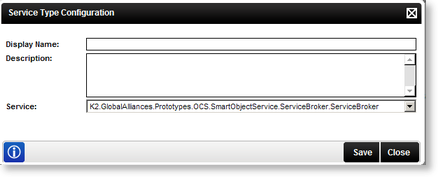K2 Management Console - SmartObject Services
Selecting the Services option of the SmartObjects Node presents the following default options:
DocuSign| Default Option | What it is |
|---|---|
| Account Management | Configures the Active Directory Account Management Service |
| Active Directory Service 2 | Configures the Active Directory SmartObject Service |
| Azure Active Directory | To register an instance for Azure Active Directory you must use the SmartObject Tester Tool. Registering the service through workspace will not work. |
| CRM Entity | Configures the CRM Entity Service |
| CRM Functions | Configures the CRM Functions Service |
| DocuSign | Configures the DocuSign Service |
| Endpoints Service | Configures the CRM Functions Service |
| Exchange | Configures the CRM Functions Service |
| Oracle Service | Configures the Oracle Service |
| SalesForce Service | Configures the Sales Force SmartObject Service |
| SharePoint 2013 | The K2 SharePoint 2013 Broker allows users to interact with SharePoint List, Libraries and Sites via the SharePoint CSOM (client side object model) and REST APIs. |
| SharePoint 2013 Integration | The K2 SharePoint 2013 Integration broker is an internal broker that K2 uses for integrating with SharePoint in order to gain access to SharePoint Events, Form Submit Types, Helper Methods, Settings, Setting Events, Workflow and Workflow Events. |
| SharePoint Functions | The SharePoint Functions SmartObject Service is a System SmartObject and is used by K2 blackpearl to configure Groups and Metadata in the K2 Process Designer. |
| SharePoint Service | Configures the SharePoint SmartObject Service |
| SharePoint Service V2 | Configures the SharePoint SmartObject Service |
| SharePoint Content | Configures the SharePoint Content Service |
| SharePoint Management | Configures the SharePoint Management Service |
| Smartbox Service | Configures the Smartbox SmartObject Service |
| UserRole Manager Service | Configures the User Role SmartObject Service |
| SQL Reporting Service | Configures the SQL Reporting SmartObject Service |
| SQL Server Service | Configures the SQL Server Service |
| Task Allocation Service | Configures the Task Allocation Service |
| Workflow Reporting | Configures the Workflow SmartObject Service |
| Workflow Service | Configures the Workflow SmartObject Service |
 |
For information on Transaction support in Service Instances, follow the See Also link at the foot of this page. |
Other SmartObject Services may also be available if they have been configured on the K2 platform. Each Service contains a Service Instance List which will contain Add, Edit and Delete options.

Fig. 1. Service Instance List
| Option | What it is | How to use it |
|---|---|---|
| Selected | Selects the SmartObject Service configuration, enabling an administrator to Edit or Delete the Service | Click on the option circle |
| Display Name | The name of the configured SmartObject Service | User Reference |
| Description | A description of the configured SmartObject Service | User Reference |
Add a Service Instance
To add a Service Instance to this list, click on Add. The Service Type Configuration screen is displayed. Complete the Display Name, Description, select the Service from the list and click Save. The Service Instance will be added to the list of services.

Fig. 2. Add Service
Edit a Service Instance
To edit a Service Instance, select the Service Instance, then click Edit. The Edit Service Type screen will be loaded with the information as provided previously. Edit the information as required and click Save.
SmartObject Server Exception: Timeout expired error

The error shown in the image will result if the Timeout period set in the [InstallDir]\Host Server\Bin\SourceCode.SmartObjects.Runtime.config file is exceeded when registering, editing, refreshing, or deleting a service instance of any type. To increase the Timeout value, edit the file "SourceCode.SmartObjects.Runtime.config"
Example of a configured command timeout value set to 120 seconds:
 |
<configuration> |
